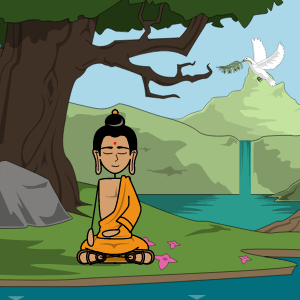Buddhalaisuuden Tosiasiat

Löydät kuvakäsikirjoituksen seuraavissa artikkeleissa ja resurssit:

Buddhalaisuus: Alkuperä ja Historia
Kirjailija: Liane Hicks
Buddhalaisuutta harjoittaa yli 500 miljoonaa ihmistä maailmanlaajuisesti ja se on maailman neljänneksi suurin uskonto. Buddhalaisuus on noin 2500 vuotta vanha ja sai alkunsa 500-luvulla Buddhan opetuksista. Se on uskonto, joka keskittyy rauhaan ja hiljaisuuteen sekä moraalisen ja hyvän elämän johtamisen tärkeyteen.
'
Kuvakäsikirjoitus Kuvaus
Pyydä oppilaita kuvaamaan ja havainnollistamaan buddhalaisuuden eri faktoja. He voivat vastata seuraaviin kysymyksiin: Mistä uskonto on syntynyt ?: Keitä olivat sen perustajat ?: Milloin se alkoi ?; Mitkä ovat keskeisiä uskomuksia ?; Mitkä ovat esimerkkejä pyhistä esineistä tai symboleista ?: Kuinka sen seuraajat palvovat / palvontataloja; Keitä sen hengelliset johtajat ovat?
Kuvakäsikirjoitus Teksti
- Liuku: 1
- ALKUPERÄÄN
- Ancient India / Lumbini Province, Nepal
- Buddhalaisuus perusti Siddhartha Gautama, joka oli hindu prinssi syntyi Lumbini maakunnassa lähellä Himalajan vuoristossa muinaisessa Intiassa, nykyajan Nepalissa.
- Liuku: 2
- VUOTTA se alkoi
- 6th Century BCE
- Siddhartha Gautama was born circa 623 BCE. He traveled throughout India teaching his ideas about inner peace and how to end suffering. He is known as the Buddha. In the 3rd century B.C., Ashoka the Great, the Mauryan Indian emperor, made Buddhism the state religion of India. While Buddhism in India eventually declined, over the next few centuries, Buddhism spread beyond India to much of east and southeast Asia.
- Liuku: 3
- FOUNDERS
- Siddhartha was a Hindu prince. Upon discovering sickness, old age, and death outside the palace walls, he left his privileged life to meditate and seek an answer to the root causes of human suffering. He achieved enlightenment at the age of 35 after meditating for several days under what is known as the Bodhi tree and became the Buddha. He taught his followers that the way to Nirvana was by following the Four Noble Truths and the Eightfold path.
- Liuku: 4
- uskomukset
- The Eightfold Path
- Right Understanding
- Right Concentration
- oikea Ajatus
- Right Mindfulness
- Right Effort
- Right Livelihood
- Right Speech
- Right Action
- Buddha opetti neljä jaloa totuutta: 1) Koko elämään sisältyy kärsimystä; 2) Itsekkäät toiveet ovat kärsimyksen syy; 3) Ihmiset voivat lopettaa kärsimyksensä luopumalla itsekkäistä haluista ja saavuttaa Nirvana; 4) Kahdenkertaisen polun seuraaminen auttaa saavuttamaan Nirvanan. Buddhalaiset uskovat myös reinkarnaatioon. Ihmiset syntyvät uudelleen kuolemansa jälkeen ja käyvät läpi syntymän, elämisen, kuoleman ja uudestisyntymisen syklit. He uskovat, että kenellekään ei pidä tehdä mitään haittaa.
- Liuku: 5
- Symbolit ESINEET
- Mala are prayer beads used in Buddhism and other religions. Prayer wheels contain a tightly scrolled paper of a mantra or prayers. When spun, the prayers sent out multiply. Other sacred objects are prayer bells, conch shells, singing bowls, statues of the Buddha, and the Om which represents the ultimate reality, consciousness, or Atman.
- Liuku: 6
- Palvontapaikat
- A Buddhist temple or monastery is a place of worship for Buddhists. They include a vihara, chaitya, wat, pagoda, and stupa. Stupas are dome-shaped structures erected as Buddhist shrines. They contain relics, typically the ashes of Buddhist monks, and are used by Buddhists as a place of meditation.
- Liuku: 7
- SPIRITUAL LEADERS
- “I believe that the very purpose of life is to be happy. From the very core of our being, we desire contentment. ... Since we are not solely material creatures, it is a mistake to place all our hopes for happiness on external development alone. The key is to develop inner peace.”
- While there are different sects of Buddhism, the Dalai Lama is the spiritual leader of the Tibetan Buddhists. He was awarded the Nobel Peace Prize in 1989 and the U.S. Congressional Gold Medal in 2007. Dalai Lama means Ocean of Wisdom. Other Buddhist leaders include monks, who are usually men, and nuns, who are women.
- Liuku: 8
- VÄESTÖ TÄNÄÄN
- Over 500 Million Followers
- All over the world but mainly in East and Southeast Asia
- Buddhists represent about 7% of the world's population. People practice Buddhism throughout the world but most are located in east and southeast Asia in China, Nepal, India, Sri Lanka, Myanmar, Cambodia, Laos, Thailand, Korea, and Japan.
Yli 30 miljoonaa kuvakäsikirjoitusta luotu
Ei Latauksia, ei Luottokorttia ja ei Vaadi Kirjautumista Kokeilemiseen!






